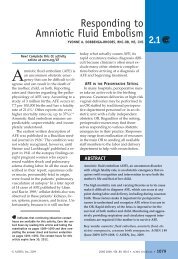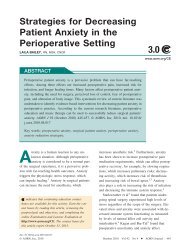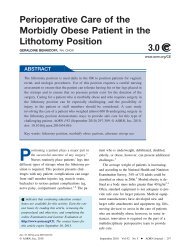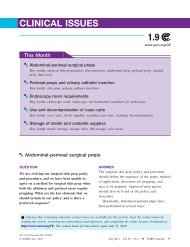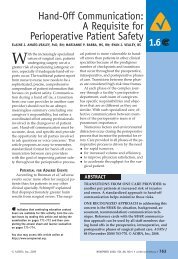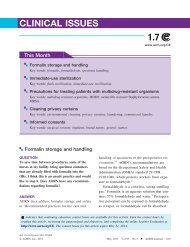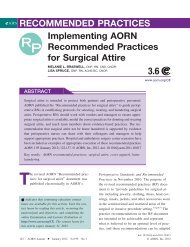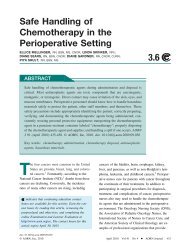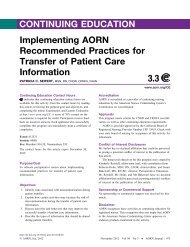You also want an ePaper? Increase the reach of your titles
YUMPU automatically turns print PDFs into web optimized ePapers that Google loves.
Winters — Obriot JANUARY 2007, VOL 85, NO 1TABLE 1Common Medical Terms Associated with <strong>Mitral</strong> <strong>Valve</strong> <strong>Repair</strong>AnnulusA ring-like structure; a fibrous band of tissue whichserves as the attachment point for the leafletsAnnuloplastySurgical repair of a deformed annulus surroundinga diseased mitral valveBicuspid valveA valve consisting of two leaflets (eg, the mitralvalve)CoaptationThe proper joining or fitting together of two surfaces(eg, mitral valve leaflets)Geometric mitral diseaseA dysfunction of the mitral valve related to dilationof the left ventricleLeft ventricular outflow tractA pathway from which blood exits the left ventricleand passes through the aortic valve<strong>Mitral</strong> regurgitationA backward flowing of blood into the left atrium ofthe heart caused by an incompetent mitral valve<strong>Mitral</strong> stenosisObstruction to the flow of blood through themitral valve, usually caused by narrowing of thevalve orificeSubvalvular apparatusChordae tendineae and papillary muscles withinthe left ventricle that contribute to the geometryand function of the mitral valveTrigoneThree angled section on the ends of the fibrousregion between the aortic and mitral valvesValvular mitral disease<strong>Valve</strong> dysfunction related to issues of the valve orsubvalvular apparatusZone of coaptationRough surface of mitral valve leaflets that jointogether during left ventricular systolesubvalvular apparatus are all normal.The problem is within the ventricle,which has become dilated to the extentthat the normal function of the valve isdisrupted.VALVULAR DISEASE. Valvular mitral diseaseis a process in which the leafletsand/or the annulus have become calcifiedand stiff or fused. In addition to calcification,valvular disease also mayinclude chordal shortening, which maylead to mitral stenosis or regurgitation.In the United States, valvular diseasemost commonly is caused by rheumaticendocarditis. 4 Whatever the etiology,most patients will have some degree ofdilation in the mitral annulus that mustbe repaired. 5MITRAL VALVE ANATOMY AND PHYSIOLOGYThe bicuspid (ie, two leaflet) mitralvalve is located between the left ventricleand left atrium. The valvular complexconsists of the annulus, leaflets,chordae tendineae, and papillary muscles(Figure 1), and in a sense, the leftventricle is the mitral valve. The annulus,a fibrous band of tissue from whichthe leaflets originate, is considered the“hinge line” of the valve leaflets. 6Continuing out from the annulus, thetwo leaflets (ie, anterior and posterior)are pale yellow, thin, fibroelastic membraneswhose anterior surfaces are relativelysmooth. The posterior or ventricularsurfaces are slightly irregularbecause of the attachments to the chordaetendineae.The anterior leaflet is also known asthe anteromedial, septal, or aorticleaflet. 4 The posterior leaflet, alsoknown as the mural leaflet, is furtherdivided into three cusps commonlyknown as P1, P2, and P3. The three posteriorcusps do not have separate functions;they have been named purely forease of describing mitral valve anatomyand locations of regurgitation jets (ie,flashes of backward blood flow).The chordae tendineae are attachedto the inferior surface of the leaflets.These white, cord-like tendons act onlyas guides to assist in the coaptation ofthe two leaflets. The chordae tendineae<strong>AORN</strong> JOURNAL • 153



